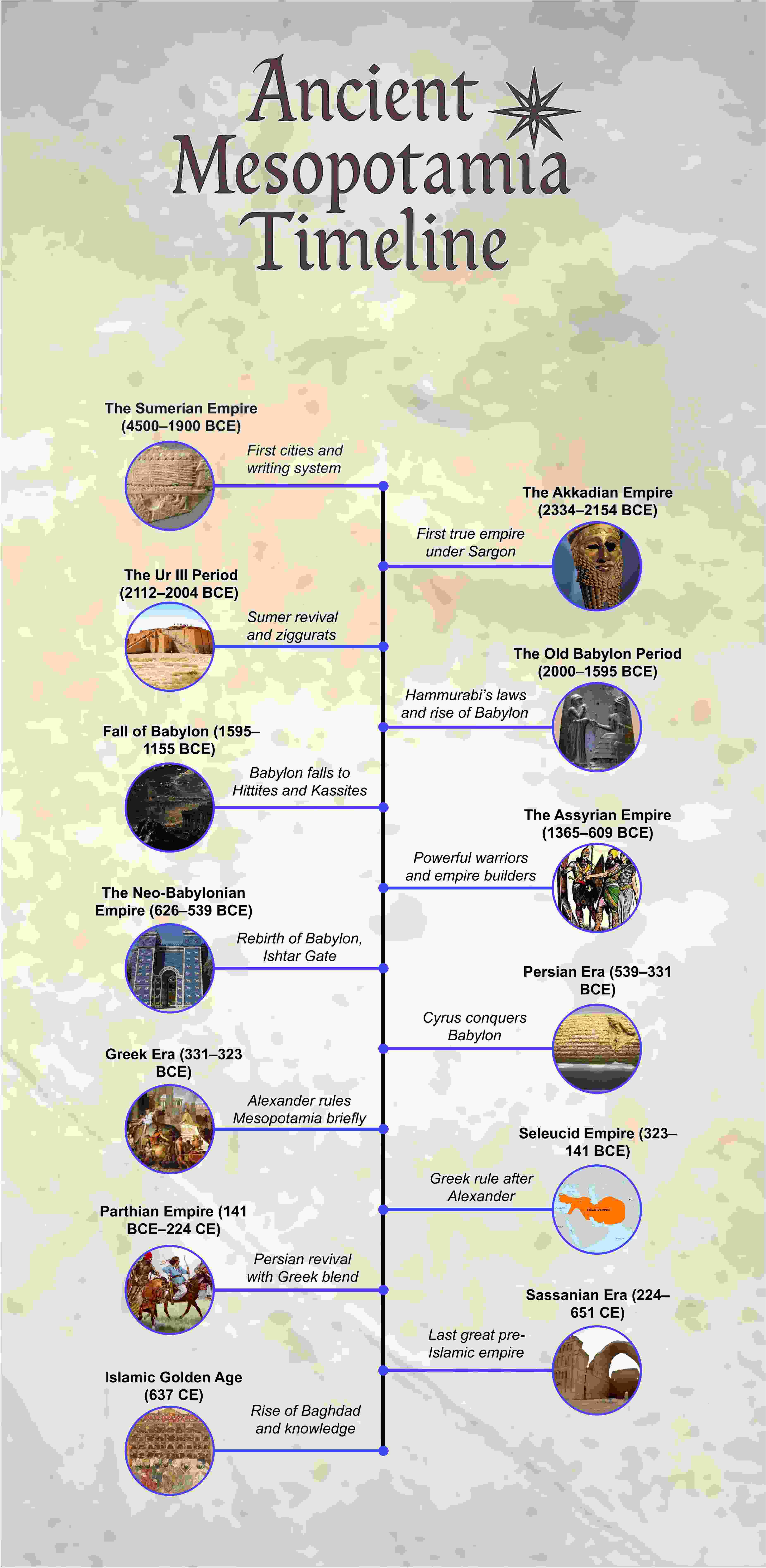Ancient Mesopotamia isn’t just a page in a history book. It’s the story of one of the greatest civilizations to ever rule the Earth. Situated between the Tigris and Euphrates Rivers, its strategic location made it a thriving hub of trade and knowledge. But that same position also made it a constant target for invaders seeking wealth and power.
Looking at the ancient Mesopotamian timeline, it’s clear why it’s called the cradle of civilization. From the Sumerians’ cuneiform, the first writing system, to Babylon’s Code of Hammurabi, one of the earliest legal systems. Mesopotamia left behind a blueprint for every civilization that followed.
In this article, we’ll explore the Mesopotamian civilization timeline. We will also uncover their most groundbreaking achievements.
In this article
The Mesopotamian Civilization Timeline
The history of ancient Mesopotamia lasted for almost three thousand years. During the time, humans advanced significantly in agriculture, writing systems, and textiles. The inventions of that era effectively transformed human lives forever.
While navigating the ancient Mesopotamian timeline is exciting. Keeping track of the many empires that rose and fell can be tricky. That’s why we’ve created an in-depth timeline to help you understand why Mesopotamia is called the birthplace of civilization.
The Sumerian Empire (4500-1900 BCE)
The first people to rule ancient Mesopotamia were the Sumerians. They migrated to the region around 5000 years ago and created cities with a modern layout. The Sumerians learned to use water for agriculture, a feat that enabled them to prosper economically. They also built ships that helped them travel to other parts of the world, like Harappa, for trading.
The Akkadian Empire (2334-2154 BCE)
The Akkadian Empire was created by Sargon of Akkad, also called Sargon the Great. He came from humble beginnings but grew into a powerful military leader over time. His armies conquered Sumerian cities in the south and pushed into northern Mesopotamia, and even into Anatolia.
The Akkadians were the first to combine different cultures, languages, and cities under one centralized rule. They are also remembered for standardising weights and measures, and promoting art and literature. The Akkadian Empire eventually collapsed because of internal rebellions and outside invasions.
The Ur III Period (2112-2004 BCE)
After the Akkadian Empire fell, the city of Ur, under Ur-Nammu, rose in power. He took over Southern Mesopotamia, beginning a new era of knowledge and innovations. Ur Nammu established the Code of Ur-Nammu, one of the oldest legal codes. His successors established a centralized government. They built massive architectural wonders like the ziggurats.
The Ur III era was highly organized, with the government keeping track of trade, taxes, and labor on clay tablets. But despite all their inventions, the civilization fell victim to internal revolts and economic decay.
The Old Babylonian Period (2000-1595 BCE)
When the Akkadian Empire fell, Mesopotamia split. The northern part became Assyria, and the southern part became Babylon. The latter was inhabited by Amorites, a Semitic-speaking people, who had migrated to Mesopotamia. Under the rule of King Hammurabi, the Amorites of Old Babylon rose in power and influence.
The king established the Code of Hammurabi, another legal system that encompassed everything from trade to family law. This era was rich in literature, astronomy, and mathematics. And many Sumerian literary works remain preserved till today.
Fall of Babylon (1595-1155 BCE)
After the death of King Hammurabi, Old Babylon split into different groups. One of them was the Hittites. They attacked the north and captured the region. However, they were very small in number compared to Mesopotamia’s size. So, while they established a new rule in the north, another tribe called the Kassites quickly took over Mesopotamia. They also changed Babylon’s name to Karduniaš.
The Assyrian Empire (1365–609 BCE)
The Assyrians were named after the city of Aššur, located in northern Mesopotamia. Although their empire existed in various forms for over a thousand years. They became most prominent during the Neo-Assyrian Empire (911–609 BCE).
The Assyrians were known for their aggressive armies, always focused on capturing more land. They were efficient and ruthless, traits that kept enemies at bay. Among their architectural achievements were massive palaces and the Library of Ashurbanipal. This library preserved thousands of clay tablets, including the Epic of Gilgamesh.
The Neo-Babylonian Empire (626–539 BCE)
When Nabopolassar of Babylon defeated Assyria with the help of the Medes, Babylon once again became the center of Mesopotamia. One of its most prominent rulers was King Nebuchadnezzar II. Under his reign, the empire expanded greatly, and he is also credited with building the legendary Hanging Gardens of Babylon.
The Neo-Babylonian Empire revived both Sumerian and Akkadian culture. They also made significant advances in mathematics and astronomy. Once a thriving hub of knowledge and trade, the empire began to decline after Nebuchadnezzar’s death. His descendants failed to maintain his legacy. And this weakness gave the Persian king, Cyrus the Great, the opportunity he had been waiting for.
Persian Era (539-331 BCE)
When Cyrus entered Babylon, he was not met with much resistance. Instead of arriving as a destroyer, he was welcomed as a liberator. Although he was of Persian descent, he allowed the people of Babylon to continue practicing their traditions and religion. He even permitted the Jews who had been exiled to return home.
Under Cyrus the Great, Mesopotamia became part of a vast empire stretching from the Indus Valley to Egypt and Greece. He established provincial governors to manage local administration, law, and taxes. This satrap's system allowed the people greater autonomy over their religion and customs.
Greek Era (331-323 BCE)
The Persian King was eventually defeated in 331 BCE by Alexander the Great. Following in Cyrus’ footsteps, Alexander also allowed the Mesopotamians to practice their religion and traditions. However, his rule was short-lived as he died in 323 BCE.
Seleucid Empire (323-141 BCE)
After Alexander’s death, his generals fought to claim Mesopotamia for themselves. One of them, Seleucus I Nicator, seized control of Babylon. He was an ambitious ruler who expanded his territory to include Mesopotamia, Syria, Persia, and parts of Anatolia.
Under the Seleucid Empire, many new cities were founded. Seleucia on the Tigris replaced Babylon as the administrative center. Greek became the official language, though the locals were still free to follow their own customs and traditions.
Parthian Empire (141 BCE- 224 CE)
The Parthians were originally nomads from the Parni tribe. They rose from the northeastern regions of Mesopotamia and defeated the Seleucids. Under their rule, the capital shifted from Seleucia on the Tigris to Ctesiphon. While the Greeks in the region continued to follow their traditions, their influence gradually declined.
The Parthian Empire thrived economically, controlling trade in silk, spices, and precious metals. However, they were in frequent conflict with the Roman Empire. In the end, it was internal strife that ultimately led to their downfall.
Sassanian Era (224-651 CE)
In 224 CE, Ardashir I founded the Sassanian Empire after defeating the Parthian king. The Sassanians wanted to restore the glory of the earlier Achaemenid Empire. So, he made Zoroastrianism the state religion. Under his rule, Mesopotamia flourished as a center of trade and agriculture.
The Sassanians also invested heavily in architecture, constructing massive palaces, canals, and bridges. But like their predecessors, they fought many battles with the Romans. These wars eventually weakened the empire. And when Arab Muslims arrived in Mesopotamia, the Sassanians were too weak to fight back.
Islamic Golden Age (637 CE)
Muslims conquered Mesopotamia during the Abbasid Caliphate. And the capital shifted to Baghdad, which soon became one of the greatest cities of the medieval world. The region transformed into a hub of knowledge. It attracted scholars from across the globe to translate and preserve ancient texts.
Mesopotamia advanced rapidly in medicine, astronomy, science, and mathematics. At the same time, trade routes to Africa, Europe, and Asia brought immense wealth to its rulers. However, this Golden Era came to an abrupt end in 1258 when the Mongols sacked Baghdad.
How to Create Such a Timeline using EdrawMax?
Want to create a timeline like the one above? Give EdrawMax a try. It offers hundreds of ready-made templates, powerful customization options, and an extensive library of symbols. Best of all, its intuitive interface makes it perfect for both beginners and professionals.
Whether you’re designing from scratch or customizing a template to save time, EdrawMax has everything you need to craft professional, eye-catching timelines. Just download the app and start creating.
Step 1Start With a Blank Canvas
- Open EdrawMax on your desktop.
- Click New on the left panel and select Blank Drawing to open a new canvas.

Step 2Insert Background Image
- Locate Insert on the top toolbar and select Picture from the options.
- Choose Local pictures and upload an image to use as the timeline’s background.
- You can also adjust the image’s brightness, contrast, and transparency through the image editing panel.
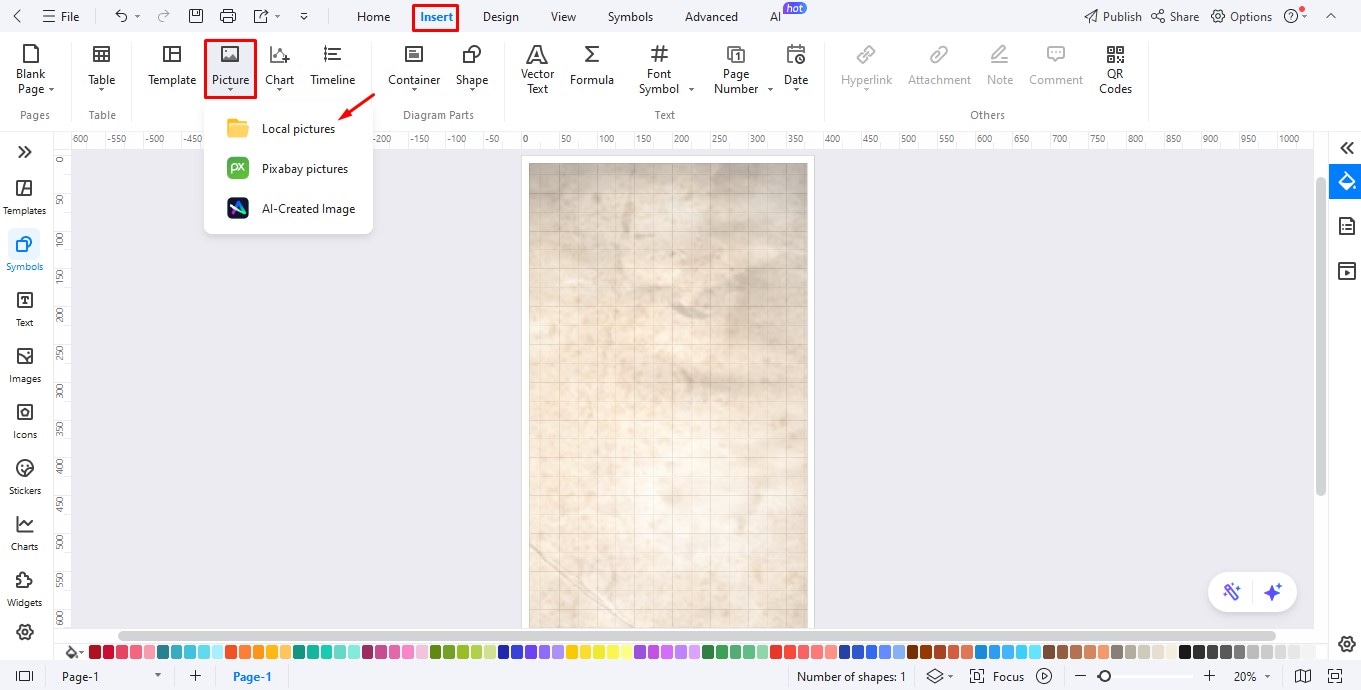
Step 3Add a Heading to the Timeline
- You can either add a heading to the timeline through a text box or an inserted image. Let’s use an image for this timeline.
- Follow the steps outlined in the previous step: Insert > Picture > Local Pictures to add an image as the heading.
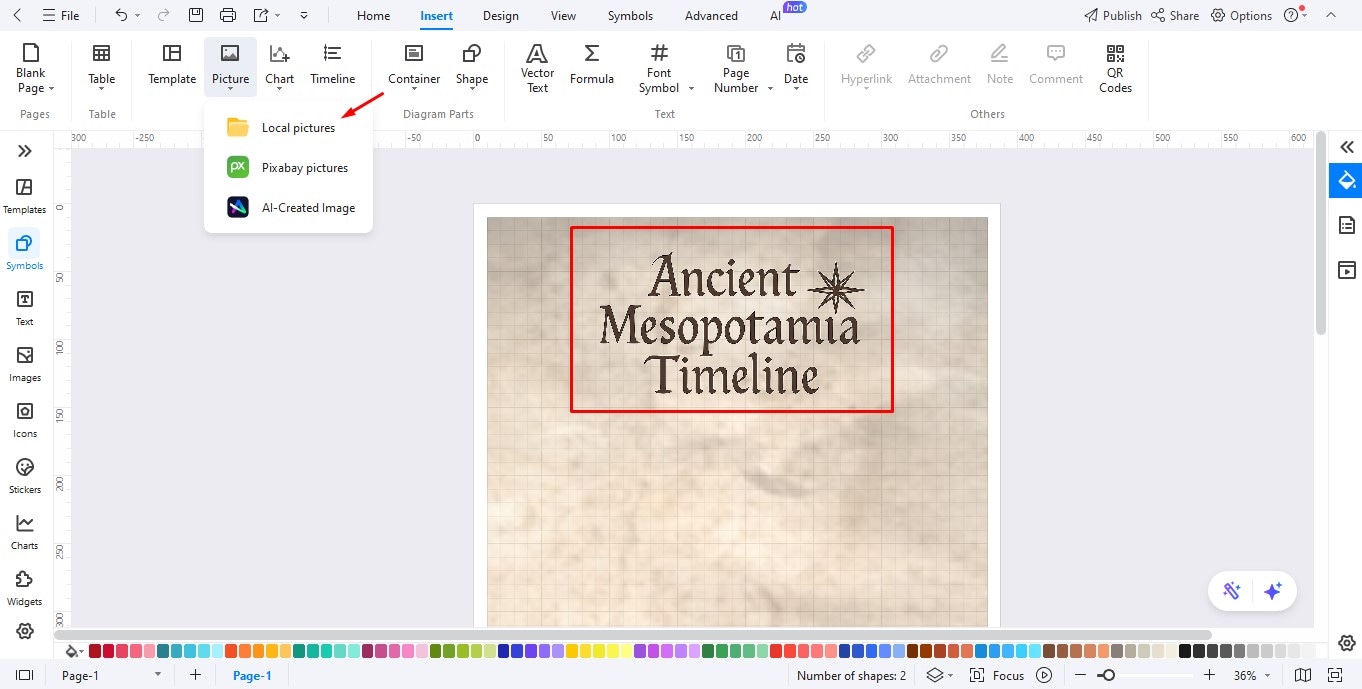
Step 4Insert Timeline
- You can create a custom timeline using Connectors or use a prebuilt timeline template to get started. We will use the timeline template for this diagram.
- Click Insert on the top panel and select Timeline.
- Scroll down to Vertical Timeline and choose the 4th timeline option that includes images.
- Click OK.
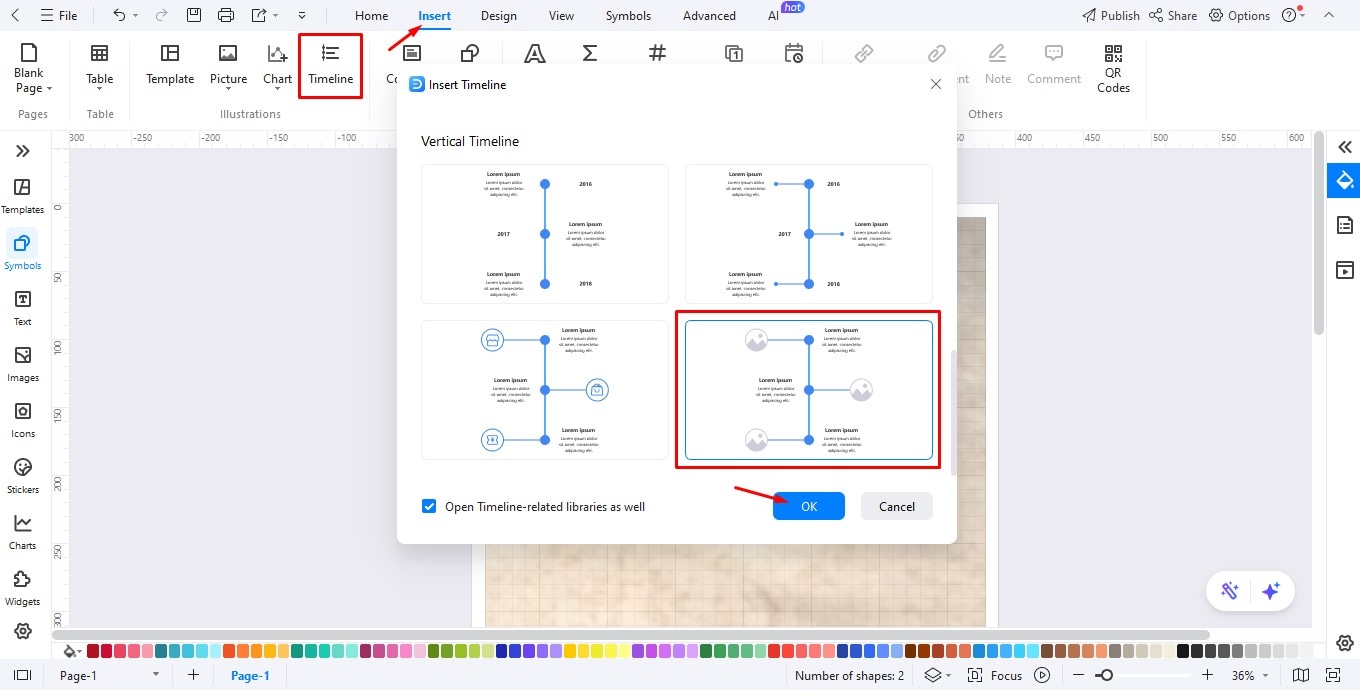
Step 5Add Text to the Timeline
- Locate and click Text on the left editing panel.
- Choose Click to Add Subtitle and insert the first empire in the timeline.
- Select Click to Add Body to highlight major achievements of that empire.
- Complete the timeline by adding all the names, dates, and highlights.
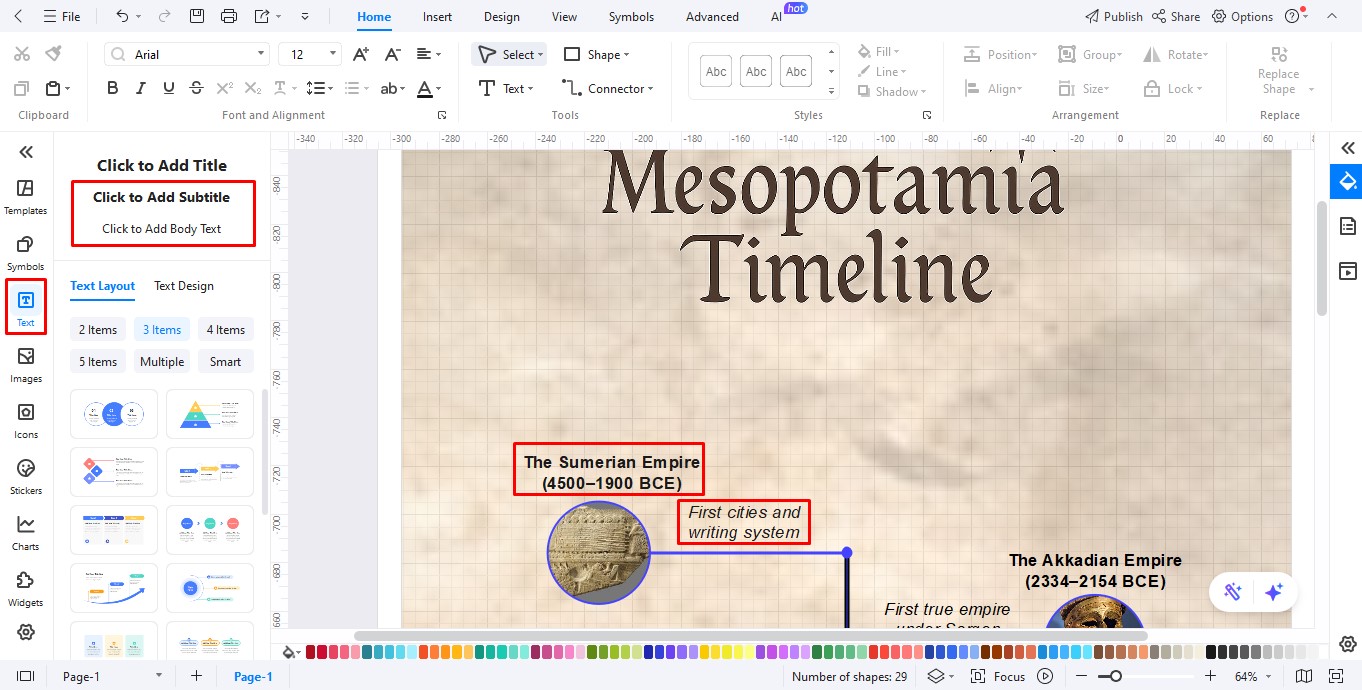
Step 6Insert Thumbnail Images
- Thumbnails make your timeline look more professional, so let’s add some images. Follow the steps: Insert > Picture > Local pictures and add thumbnails to the timeline.
- You can change the image outline by clicking on the thumbnail. When the customization panel appears, select Crop to Shape and pick an outline you like.
- Follow the same steps to add the rest of the thumbnails.

Step 7Export Image
- Once the timeline is complete, you can save the image.
- Click Export on the top panel to view your saving options.
- With EdrawMax, you can export the timeline in various formats, including JPG, PDF, Word, Visio, GIF, etc.
- Select Graphics and save the file in JPG format.
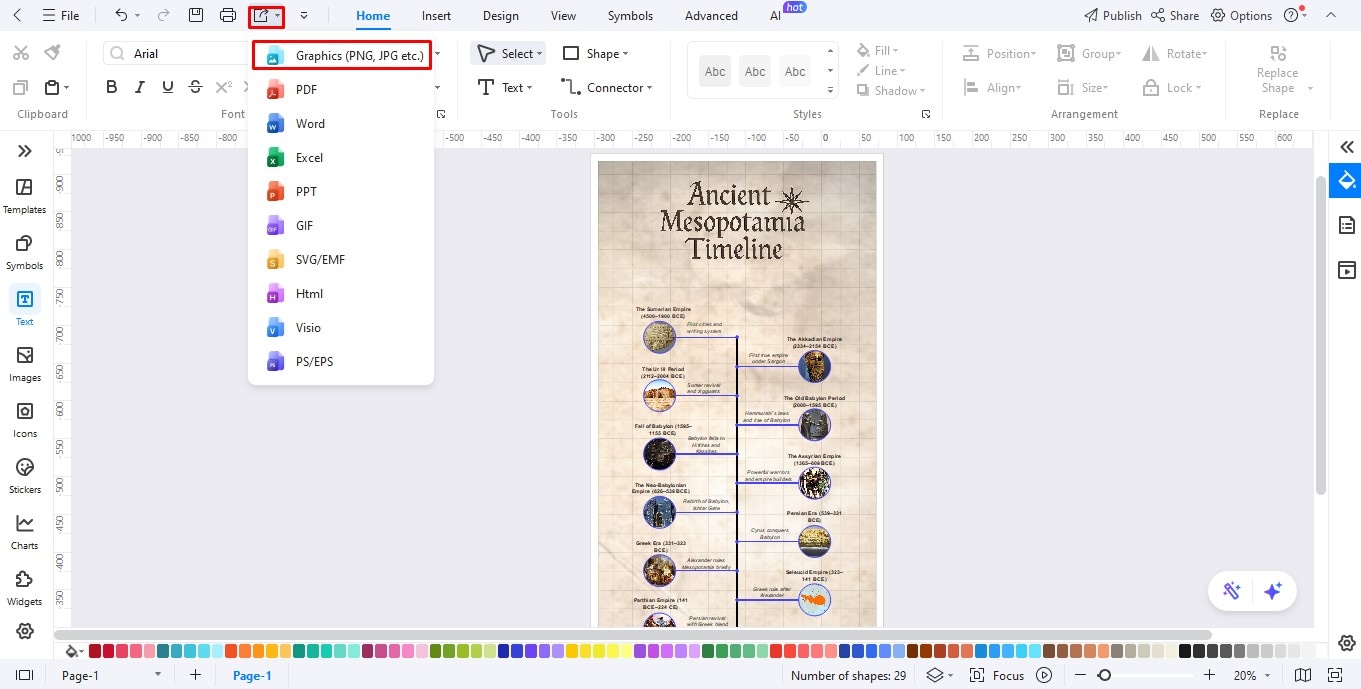
Final Words
The timeline of Mesopotamia is a reminder of our ancestors’ extraordinary feats. Each empire left behind a mark, not just in history, but in science, law, astronomy, and much more. If you enjoy exploring ancient civilizations, you’ll love bringing them to life by creating your own timelines with EdrawMax.
Whether you’re a beginner with no design expertise or a professional looking for an intuitive diagramming tool, EdrawMax has you covered. So, try it today.




